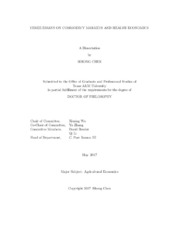| dc.contributor.advisor | Wu, Ximing | |
| dc.contributor.advisor | Zhang, Yu | |
| dc.creator | Chen, Sihong | |
| dc.date.accessioned | 2017-08-21T14:37:20Z | |
| dc.date.available | 2017-08-21T14:37:20Z | |
| dc.date.created | 2017-05 | |
| dc.date.issued | 2017-03-29 | |
| dc.date.submitted | May 2017 | |
| dc.identifier.uri | https://hdl.handle.net/1969.1/161409 | |
| dc.description.abstract | This dissertation includes three essays. The first essay examines time-varying nonlinear dependence and asymmetries of commodity futures from 1999 to 2015. We consider several elliptical copulas with dynamic conditional correlation (DCC) and block dynamic equicorrelation (Block DECO) to capture dependence structure of various commodities across different sectors. Our major findings include: (1) flexible copula specification that allows for multivariate asymmetry and tail dependence appears to have the best model performance in characterizing co-movements of commodity returns. (2) dynamic correlations reveal connectedness degree between commodities has dramatically increased during the financial distress and the European debt crisis, but they declined sharply after 2012 and returned to the precrisis level since. (3) conditional diversification benefit is disappearing and lower tail dependence between commodity markets is much higher in the bearish market.
The second essay studies volatility spillover and various connectedness measures for 20 commodity futures from 1996 to 2016. We propose to estimate network connectedness in commodity markets by a previous framework that models direction and magnitude of volatility spillover using reduced-form vector autoregression (VAR) models and generalized forecast error variance decomposition. We find clustering of commodity futures that match their industrial groupings, and energy markets have played a central role in the network in the static analysis. Our dynamic models show that though market interconnections have dramatically increased during the 2007-2009 financial crisis, they have returned to the pre-crisis levels after. We also find that recent downward movement of crude oil prices does not necessarily lead to stronger connectedness between commodity markets.
The third essay investigates health economics in developing countries. Obesity and overweight problems have become prevalent in developing countries like China. This paper presents a comprehensive analysis on body mass index (BMI) using a micro-level data of Chinese families. We model the dynamics of BMI determinants spanning from 1991 to 2011 for rural and urban residents. Our identification strategies include: (1) using spousal and parental characteristics as proxy variables to control for omitted variables bias and (2) explicitly modeling common couple effect with correlated random-effects regressions for spousal BMI. Our results find strong and positive spousal/intergenerational transmissions of BMI for families across region and time. Depending on the gender of spouse and grown children, besides transmission effects a variety of socioeconomic variables are identified as significant predictors of individual BMI. | en |
| dc.format.mimetype | application/pdf | |
| dc.language.iso | en | |
| dc.subject | Commodity | en |
| dc.subject | Spillover | en |
| dc.subject | BMI | en |
| dc.title | Three Essays on Commodity Markets and Health Economics | en |
| dc.type | Thesis | en |
| thesis.degree.department | Agricultural Economics | en |
| thesis.degree.discipline | Agricultural Economics | en |
| thesis.degree.grantor | Texas A & M University | en |
| thesis.degree.name | Doctor of Philosophy | en |
| thesis.degree.level | Doctoral | en |
| dc.contributor.committeeMember | Bessler, David | |
| dc.contributor.committeeMember | Li, Qi | |
| dc.type.material | text | en |
| dc.date.updated | 2017-08-21T14:37:20Z | |
| local.etdauthor.orcid | 0000-0002-9471-0323 | |


